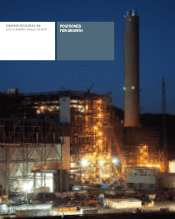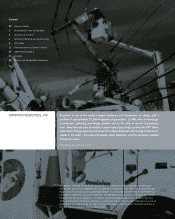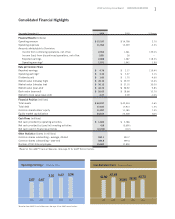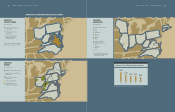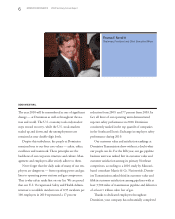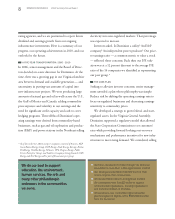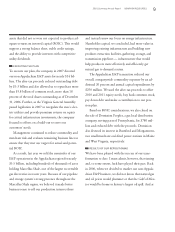Dominion Power 2010 Annual Report Download - page 9
Download and view the complete annual report
Please find page 9 of the 2010 Dominion Power annual report below. You can navigate through the pages in the report by either clicking on the pages listed below, or by using the keyword search tool below to find specific information within the annual report.
6XPPDU\ $QQXDO 5HSRUW'20,1,21 5(6285&(6
assets that did not or were not expected to produce ad-
equate returns on invested capital (ROIC). This would
support a strong balance sheet, stable credit ratings,
and the ability to provide investors with competitive
utility dividends.
(;(&87,1* 7+( 3/$1
To execute our plan, the company in 2007 divested
our non-Appalachian E&P assets for nearly $14 bil-
lion. The after-tax proceeds reduced outstanding debt
by $3.3 billion and also allowed us to repurchase more
than $5.8 billion of common stock, more than 18
percent of the total shares outstanding as of December
31, 2006. Further, as theVirginia General Assembly
passed legislation in 2007 to reregulate the state’s elec-
tric utilities and provide premium returns on equity
for critical infrastructure investments, the company
focused its efforts on a build-out to serve our
customers’ needs.
Management continued to reduce commodity and
merchant risk and evaluate remaining business lines to
ensure that they met our targets for actual and poten-
tial ROIC.
As a result, last year we sold the remainder of our
E&P operations in the Appalachian region for nearly
$3.5 billion, including hundreds of thousands of acres
holding Marcellus Shale, one of the largest recoverable
gas discoveries in recent years. Because of our pipeline
and storage system’s strong presence throughout the
Marcellus Shale region, we believed it made better
business sense to sell our production interests there
and instead renew our focus on energy infrastructure.
Shareholder capital, we concluded, had more value in
improving existing infrastructure and building new
products extraction facilities, gathering, storage, and
transmission pipelines — infrastructure that would
help producers more effectively and efficiently get
natural gas to demand centers.
The Appalachian E&P transaction reduced our
overall, companywide commodity exposure by an ad-
ditional 20 percent and annual capital expenditures by
$250 million. We used the after-tax proceeds to offset
2010 and 2011 equity needs, buy back common stock,
pay down debt and make a contribution to our pen-
sion plan.
Based on ROIC considerations, we also closed on
the sale of Dominion Peoples, a gas local distribution
company serving parts of Pennsylvania, for $780 mil-
lion and reduced debt with the proceeds. Dominion
also divested its interest in Rumford and Morgantown,
two small merchant coal-fired power stations in Maine
and West Virginia, respectively.
5(68/76 2) 285 5(326,7,21,1*
We have been pleased with the success of our trans-
formation to date. I must admit, however, that timing
and, to some extent, luck have played their part. Back
in 2006, when we decided to market our non-Appala-
chian E&P business, we did not know that natural gas
and oil prices would plummet or that the Gulf of Mex-
ico would be home to history’s largest oil spill. And at
'20,1,21 5(6285&(6 6XPPDU\ $QQXDO 5HSRUW
32:(5,1*9,5*,1,$
3/($6( /,)7
'20,1,21·6
75$16)250$7,21
*52:7+ ²
6XPPDU\ $QQXDO 5HSRUW'20,1,21 5(6285&(6

